National Bureau of Statistics: In the first half of 2023, the national real estate development investment was 5,855 billion yuan.
CCTV News:According to the website of the National Bureau of Statistics, the basic situation of the national real estate market in the first half of 2023 is announced as follows:
I. Completion of investment in real estate development
In the first half of the year, the national investment in real estate development was 5,855 billion yuan, down by 7.9% year-on-year (see Note 6 for details in terms of comparable caliber); Among them, residential investment was 4,443.9 billion yuan, down 7.3%.
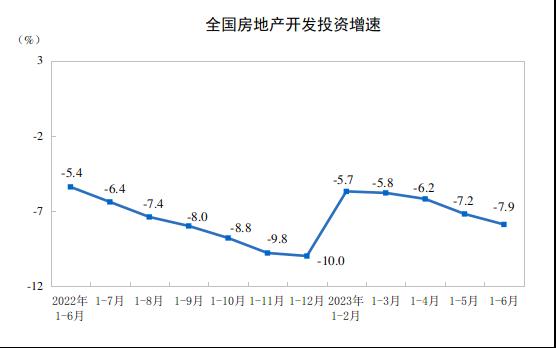
In the first half of the year, the housing construction area of real estate development enterprises was 7,915.48 million square meters, down 6.6% year-on-year. Among them, the residential construction area was 5,570.83 million square meters, down 6.9%. The newly started housing area was 498.8 million square meters, down by 24.3%. Among them, the newly started residential area was 363.4 million square meters, down by 24.9%. The completed housing area was 339.04 million square meters, an increase of 19.0%. Among them, the completed residential area was 246.04 million square meters, an increase of 18.5%.
Second, the sale and sale of commercial housing
In the first half of the year, the sales area of commercial housing was 595.15 million square meters, down 5.3% year-on-year, of which the sales area of residential housing decreased by 2.8%. The sales of commercial housing reached 6,309.2 billion yuan, up by 1.1%, of which residential sales increased by 3.7%.
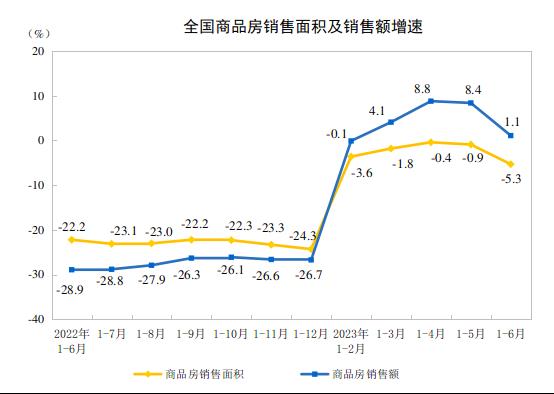
At the end of June, the area of commercial housing for sale was 641.59 million square meters, a year-on-year increase of 17.0%. Among them, the residential area for sale increased by 18.0%.
Three, the real estate development enterprise funds in place
In the first half of the year, real estate development enterprises received 6,879.7 billion yuan in funds, down 9.8% year-on-year. Among them, domestic loans were 869.1 billion yuan, down by 11.1%; The utilization of foreign capital was 2.8 billion yuan, down by 49.1%; Self-raised funds were 2,056.1 billion yuan, down by 23.4%; Deposits and advance receipts were 2,427.5 billion yuan, down by 0.9%; Personal mortgage loans reached 1,242.9 billion yuan, up by 2.7%.
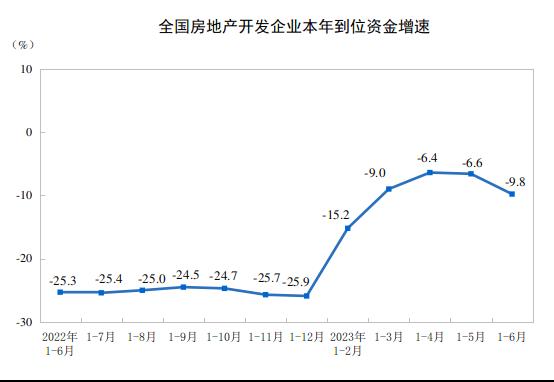
Fourth, the real estate development boom index
In June, the real estate development boom index (referred to as "national housing boom index") was 94.06.
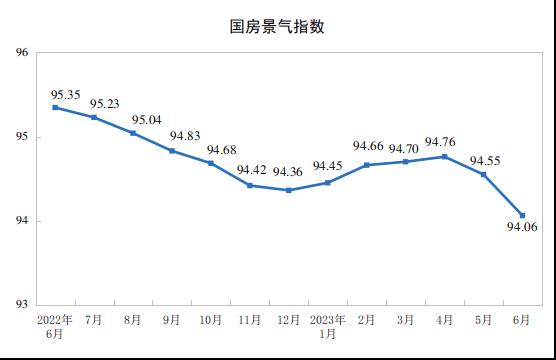
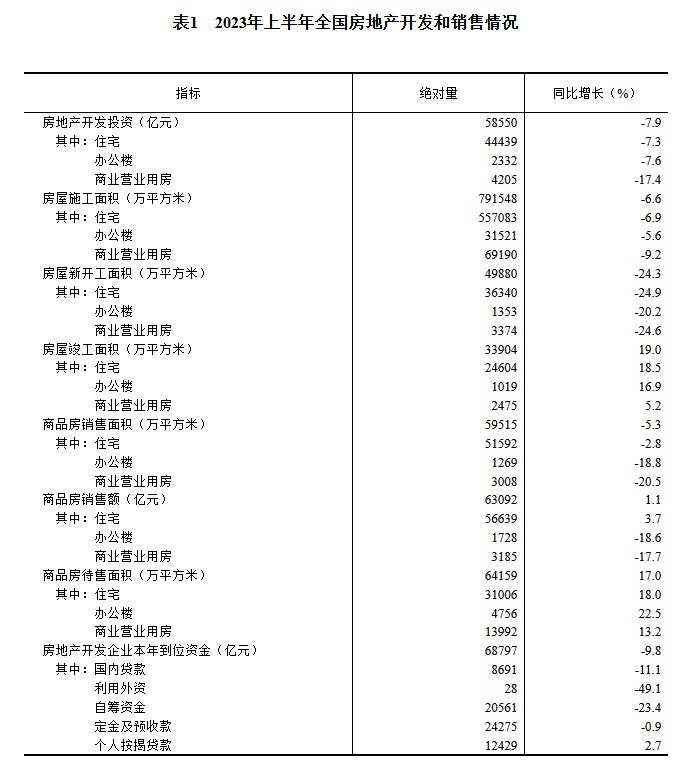

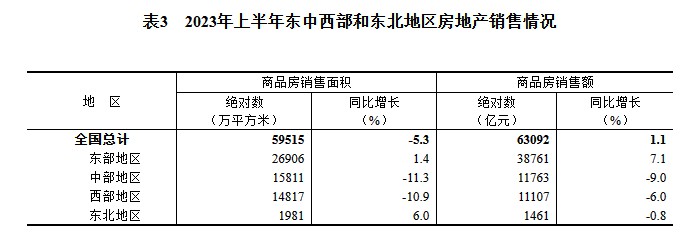
annotations
1. Interpretation of indicators
Investment completed by real estate development enterprises this year: refers to all the investment completed during the reporting period for housing construction projects, land development projects, public welfare buildings and land purchase fees. This indicator is cumulative data.
Sales area of commercial housing: refers to the total contracted area of newly-built commercial housing sold during the reporting period (i.e. the construction area confirmed in the formal sales contract signed by both parties). This indicator is cumulative data.
Sales of commercial housing: refers to the total contract price of selling new commercial housing during the reporting period (i.e. the total contract price confirmed in the formal sales contract signed by both parties). This indicator is the same caliber as the sales area of commercial housing, and it is also cumulative data.
Sale area of commercial housing: refers to the construction area of commercial housing that has been completed for sale or lease at the end of the reporting period, but has not been sold or leased, including the housing areas completed in previous years and completed in this period, but excluding the housing areas that have been completed in the reporting period, such as demolition and reconstruction, unified construction and agent construction, public supporting buildings, real estate companies’ own use and revolving houses, which cannot be sold or leased.
Funds paid by real estate development enterprises this year: refers to all kinds of monetary funds and source channels actually used by real estate development enterprises for real estate development during the reporting period. It is subdivided into domestic loans, utilization of foreign capital, self-raised funds, deposits and advance receipts, personal mortgage loans and other funds. This indicator is cumulative data.
Housing construction area: refers to the total housing construction area constructed by real estate development enterprises during the reporting period. Including the area newly started in this period, the area of houses that entered this period in the previous period and continued to be constructed, the area of houses that were suspended in the previous period and resumed construction in this period, the area of houses completed in this period and the area of houses that were suspended after construction in this period. The construction area of multi-storey buildings refers to the sum of the construction areas of each floor.
Newly started housing area: refers to the newly started housing area of real estate development enterprises during the reporting period, with unit projects as the accounting object. It does not include the construction area of houses that started construction in the last period and continued construction in the reporting period, and the construction area that stopped construction in the last period and resumed work in this period. The construction of the house shall be based on the date when the house officially begins to break ground and dig trenches (foundation treatment or permanent piling). The newly started building area refers to the total building area of the whole building and cannot be calculated separately.
Completed building area: refers to the total building area of all buildings that have been completed according to the design requirements, reached the living and use conditions, passed the acceptance inspection or reached the completion acceptance standard, and can be officially handed over for use during the reporting period.
2. Statistical scope
All real estate development and operation legal entities with development and operation activities.
3. Investigation methods
Conduct a comprehensive survey on a monthly basis (except January).
4. Brief description of the national real estate development boom index.
The national real estate development boom index (hereinafter referred to as "national housing boom index") follows the theory of economic cycle fluctuation, is based on the boom cycle theory and boom cycle analysis method, uses time series, multivariate statistics and econometric analysis methods, takes real estate development investment as the benchmark index, selects relevant indicators of real estate investment, capital, area and sales, and excludes the influence of seasonal factors, including random factors. It is compiled by the growth rate cycle method, and is compiled monthly according to the newly added data. The national housing boom index chooses 2012 as the base year and sets its growth level at 100. Under normal circumstances, the national housing boom index is 100 points, which is the most suitable boom level, with a moderate boom level between 95 and 105 points, a low boom level below 95 and a high boom level above 105.
5. Division of East, Central, West and Northeast China
The eastern region includes 10 provinces (cities) including Beijing, Tianjin, Hebei, Shanghai, Jiangsu, Zhejiang, Fujian, Shandong, Guangdong and Hainan; The central region includes six provinces of Shanxi, Anhui, Jiangxi, Henan, Hubei and Hunan. The western region includes 12 provinces (cities and autonomous regions) including Inner Mongolia, Guangxi, Chongqing, Sichuan, Guizhou, Yunnan, Xizang, Shaanxi, Gansu, Qinghai, Ningxia and Xinjiang. Northeast China includes Liaoning, Jilin and Heilongjiang provinces.
6. Description of year-on-year growth rate
The growth rate of real estate development investment, commercial housing sales area and other indicators are calculated according to comparable caliber. There are incomparable factors between the data of the reporting period and the published data of the same period last year, so it is impossible to directly compare and calculate the growth rate. The main reasons are as follows: (1) Strengthening the management of in-stock projects and revising the sales data of commercial housing for check-out. (two) to strengthen the statistical law enforcement, and to correct the data found in the statistical law enforcement inspection in accordance with the relevant provisions. (3) Strengthen data quality management, and exclude non-real estate development project investment and mortgage sales data.